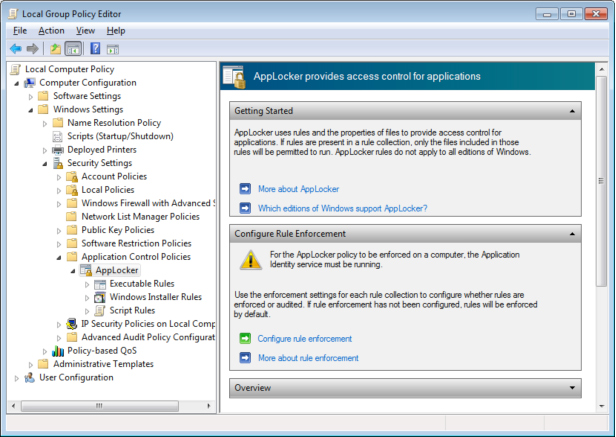


- Windows server 2012 applocker prevent internet explorer software#
- Windows server 2012 applocker prevent internet explorer license#
- Windows server 2012 applocker prevent internet explorer free#
- Windows server 2012 applocker prevent internet explorer windows#
While the computation of file hashes is enabled by default, the detection rate can be greatly enhanced using the setting EnableFileHashComputation. You can allow, audit, warn or block and remediate access to files. But you have to keep in mind that you will need to exclude each new version of an executable since the hash will change with every small change. Through the use of file hashes, you don’t have to rely on the folder path to exclude a file from MDE or MDAV behavior. This feature is configured as part of Microsoft Defender for Endpointįile hash based indicators detect files, using one of the following hash algorithms
Windows server 2012 applocker prevent internet explorer windows#
Warn IoC on Windows Server 2019 Custom indicators Indicators created for vulnerable Putty versions

More details about this type of indicator are documented here. This feature creates custom file indicators for all executables related to the vulnerable application. If MDE can block the execution of an app is only known after the creation of a remediation.Įrror message informing the admin that the mitigation action is not available for this application You cannot use this feature to block Microsoft applications, any apps for MacOS and Linux or apps where Microsoft does not have sufficient information to block the execution. This feature allows you to warn then user or block the execution of vulnerable applications.Ĭreate remediation including a mitigation action
Windows server 2012 applocker prevent internet explorer license#
It is completely integrated in the Defender portal but requires either a standalone license (Defender Vulnerability Management Standalone) or, if you already have licensed the Defender for Endpoint Plan 2 plan, you need the “Defender Vulnerability Management add-on”. Microsoft Defender Vulnerability Management is a quite new offering from Microsoft and as of writing in public preview. This feature creates custom URL indicators for all URLs related to the service. Microsoft Defender for Cloud Apps advanced feature You must also enable this integration in the “ Advanced features” section of the Defender portal. Microsoft Defender for Cloud Apps (Microsoft Cloud App Security) allows you to block unsanctioned apps using the MDE integration setting “Enforce app access”. Custom remediation action for a specific threat.Custom remediation action based on threat severity.In the next segment I will go into more depth what those different exclusions are used for. This initial section lists the exclusion types that are available in the different products. Having said this, let’s dive into the different exclusion types right away. So when talking about exclusions in this article I refer to every deviation from the default behavior.
Windows server 2012 applocker prevent internet explorer software#
to prevent certain software from being executed at all. There are so called block indicators in Microsoft Defender for Endpoint and those can be used e.g. There are also exclusions from default behavior which can also increase your security.
Windows server 2012 applocker prevent internet explorer free#
If you already know about all the exclusions that are available, feel free to skip those parts and read more about “ How exclusions and IoCs are evaluated?” or what the threat type “ EUS:Win32/CustomEnterpriseBlock” is all about.ĭefining exclusions lowers the protection offered by Microsoft Defender Antivirus. This guide will give you a (hopefully) complete overview on the different types of exclusions that are available, how those exclusions interact with each other and what potential gotchas you have to anticipate. The Hitchhiker's Guide to Microsoft Defender for Endpoint exclusions Most of these products have separate documentations, there is no single documentation page that contains all the information about exclusions available in Microsoft Defender for Endpoint. Also, there are integrations in other products, that result in possible side effects when enabling certain settings. Since Microsoft Defender for Endpoint is a suite of products, rather than just one single piece of software, there are various places where you can create exclusions for different features.


 0 kommentar(er)
0 kommentar(er)
